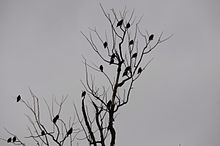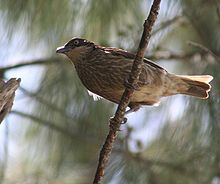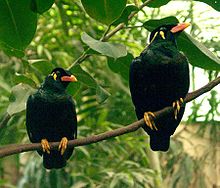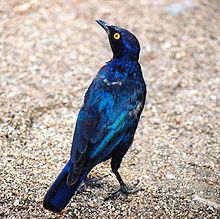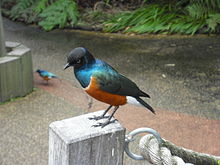
Starling
Did you know...
SOS Children, an education charity, organised this selection. SOS Child sponsorship is cool!
| Starling | |
|---|---|
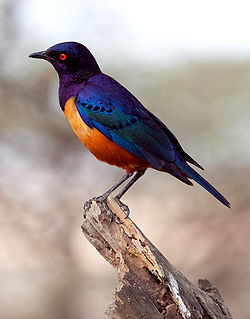 |
|
| Hildebrandt's Starling, Lamprotornis hildebrandti | |
| Scientific classification | |
| Kingdom: | Animalia |
| Phylum: | Chordata |
| Class: | Aves |
| Order: | Passeriformes |
| Suborder: | Passeri |
| Family: | Sturnidae Rafinesque, 1815 |
| Genera | |
|
Nearly 30, see text. |
|
Starlings are small to medium-sized passerine birds in the family Sturnidae. The name "Sturnidae" comes from the Latin word for starling, sturnus. Many Asian species, particularly the larger ones, are called mynas, and many African species are known as glossy starlings because of their iridescent plumage. Starlings occur naturally in the Old World, from Europe, Asia and Africa, to northern Australia and the islands of the tropical Pacific. Several European and Asian species have been introduced to these areas as well as North America, Hawaii and New Zealand, where they generally compete for habitat with native birds and are considered to be invasive species. The starling species familiar to most people in Europe and North America is the European Starling, and throughout much of Asia and the Pacific the Common Myna is indeed common.
Starlings have strong feet, their flight is strong and direct, and they are very gregarious. Their preferred habitat is fairly open country, and they eat insects and fruit. Several species live around human habitation, and are effectively omnivores. Many species search for prey such as grubs by "open-bill probing", that is, forcefully opening the bill after inserting it into a crevice, thus expanding the hole and exposing the prey; this behaviour is referred to by the German verb zirkeln (pronounced [ˈtsɪʁkəln]).
Plumage of many species is typically dark with a metallic sheen. Most species nest in holes, laying blue or white eggs.
Starlings have diverse and complex vocalizations, and have been known to embed sounds from their surroundings into their own calls, including car alarms, and human speech patterns. The birds can recognize particular individuals by their calls, and are currently the subject of research into the evolution of human language.
Description
The starlings are medium sized passerines. The shortest-bodied species is Kenrick's Starling (Poeoptera kenricki), at 15 centimetres (6 in), but the lightest-weight species is Abbott's Starling (Poeoptera femoralis), at 34 grams (1.2 oz). The largest starling, going on standard measurements and perhaps weight, is the Nias Hill Myna (Gracula robusta). This species can measure up to 36 cm (14 in) and, in domestication, can weigh up to 400 g (14 oz). Rivaling the prior species in bulk if not dimensions, the mynas of the genus Mino are also large, especially the Yellow-faced (M. dumontii) and Long-tailed Mynas (M. kreffti). The longest species in the family is the White-necked Myna (Streptocitta albicollis), which can measure up to 50 cm (20 in), although around 60% in this magpie-like species is comprised by its very long tail. Several species of starling exhibit sexual dimorphism in size.
There is less sexual dimorphism in plumage however, with only 25 species showing such differences between the sexes. The plumage of the starlings is often brightly coloured due to iridescence; this colour is derived from the structure of the feathers, not from any pigment. Some species of Asian starling have crests or erectile feathers on the crest. Other ornamentation includes elongated tail feathers and brightly coloured bare areas on the face. These colours can be derived from pigments, or, as in the Bali Starling, structural colour, caused by light scattering off parallel collagen fibres. The irises of many species are red and yellow, although those of younger birds are much darker.
Distribution, habitat and movements
The starlings inhabit a wide range of habitats from the Arctic Circle to the Equator, in fact the only habitat they do not typically occupy is the driest sandy deserts. The family is naturally absent from the Americas and from large parts of Australia, but is present over the majority of Europe, Africa and Asia. The genus Aplonis has also spread widely across the islands of the Pacific reaching Polynesia, Melanesia and Micronesia (in addition one species in the genus Mino has reached the Solomon Islands), it is also a species of this genus that is the only starling found in northern Australia.
Asian species are most common in evergreen forests; 39 species found in Asia are predominately forest birds as opposed to 24 found in more open or human modified environments. In contrast to this African species are more likely to be found in open woodlands and savannah; 33 species are open area specialists compared to 13 true forest species. The high diversity of species found in Asia and Africa is not matched by Europe, which has one widespread (and very common) species and two more restricted species. The European Starling is both highly widespread and extremely catholic in its habitat, occupying most types of open habitat. Like many other starling species it has also adapted readily to human-modified habitat, including farmland, orchards, plantations and urban areas.
Some species of starling are migratory, either entirely, like the Shelley's Starling, which breeds in Ethiopia and northern Somalia and migrates to Kenya and southern Somalia, or the White-shouldered Starling, which is migratory in part of its range but is resident in others.
The European Starling was purposefully introduced to North America in 1890-1891 by the American Acclimatization Society, by an organization that decided all birds mentioned by William Shakespeare should be there. The bird had been mentioned in Henry IV, Part 1, and a hundred of them were released from New York's Central Park.
Behaviour
The starlings are generally a highly social family. Most species associate in flocks of varying sizes throughout the year. A flock of starlings is called a murmuration. These flocks may include other species of starlings and sometimes species from other families. This sociality is particularly evident in the their roosting behaviour; in the non-breeding season some roosts can number in the thousands of birds.
Mimicry
Starlings imitate a variety of avian species and have a repertoire of about 15-20 distinct imitations. They also imitate a few sounds other than those of wild birds. The calls of abundant species, calls that are simple in frequency structure and calls that show little amplitude modulation are preferentially imitated. There are local dialects of mimicked sounds. Starlings have also been known to imitate objects, such as phone boxes and cars.
Diet and feeding
The diets of the starlings are usually dominated by fruits and insects. Many species are important dispersers of seeds in Asia and Africa, for example white sandalwood, Indian Banyan. In addition to trees they are also important dispersers of parasitic mistletoes. In South Africa the Red-winged Starling is an important disperser of the introduced Acacia cyclops. Starlings have been observed feeding on fermenting over-ripe fruit, which led to the speculation that they might become intoxicated by the alcohol. Laboratory experiments on European Starlings have found that they have disposal enzymes that allow them to break down alcohol very quickly. In addition to consuming fruits, many starlings will also consume nectar. The extent to which starlings are important pollinators is unknown, but at least some are, such as the Slender-billed Starling of alpine East Africa, which pollinates giant lobelias.
Systematics
The starlings belong to the superfamily Muscicapoidea, together with thrushes, flycatchers and chats, as well as dippers which are quite distant and Mimidae (thrashers and mockingbirds). The latter are apparently the Sturnidae's closest living relatives, replace them in the Americas, and have a rather similar but more solitary lifestyle. They are morphologically quite similar too—a partly albinistic specimen of a mimid, mislabelled as to suggest an Old World origin, was for many decades believed to represent an extinct starling (see Rodrigues Starling for details).
The oxpeckers are sometimes placed here as a subfamily, but the weight of evidence has shifted towards granting them full family status as a more basal member of the Sturnidae-Mimidae group, derived from an early expansion into Africa.
Usually the starlings are considered a family, as is done here. Sibley & Monroe (1990) included the mimids in the family and demoted the starlings to tribe rank, as Sturnini. This treatment was used by Zuccon et al. (2006). However, the grouping of Sibley & Monroe (besides leaving the subfamily rank vacant) is overly coarse due to methodological drawbacks of their DNA-DNA hybridization technique and most of their proposed revisions of taxonomic rank have not been accepted (see for example Ciconiiformes). The all-inclusive Sturnidae grouping is all but noninformative as regards biogeography, and obscures the evolutionary distinctness of the three lineages. Establishing a valid name for the clade consisting of Sibley/Monroe's "pan-Sturnidae" would nonetheless be desirable to contrast them with the other major lineages of Muscicapoidea.
Starlings probably originated in the general area of the East Asia, perhaps towards the southwestern Pacific, as evidenced by the number of plesiomorphic lineages to occur there. Expansion into Africa appears to have occurred later, as most derived forms are found there. An alternative scenario would be African origin for the entire "sturnoid" (as per Zuccon et al. 2006) group, with the oxpeckers representing an ancient relict and the mimids arriving in South America. This is contradicted by the North American distribution of the most basal Mimidae.(Cibois & Cracraft 2004, Zuccon et al. 2006)
As the fossil record is limited to quite Recent forms, the proposed Early Miocene (about 25–20 mya) divergence dates for the "sturnoids" lineages must be considered extremely tentative. Given the overall evidence for origin of most Passeri families in the first half of the Miocene, it appears to be not too far off the mark however.(Zuccon et al. 2006)
Recent studies (Cibois & Cracraft 2004, Zuccon et al. 2006) identified two major clades of this family, corresponding to the generally drab, often striped, largish "atypical mynas" and other mainly Asian-Pacific lineages, and the often smaller, sometimes highly apomorphic taxa which are most common in Africa and the Palearctic, usually have metallic coloration, and in a number of species also bright carotinoid plumage colors on the underside. Inside this latter group, there is a clade consisting of species which, again, are usually not too brightly colored, and which consists of the "typical" myna- Sturnus assemblage.
Interestingly, the Philippine creepers, a single genus of three species of treecreeper-like birds appear to be highly apomorphic members of the more initial radiation of the Sturnidae (Zuccon et al. 2006). While this may seem odd at first glance, their placement has always been contentious. In addition, biogeography virtually rules out a close relationship of Philippine creepers and treecreepers, as neither the latter nor their close relatives seem have ever reached the Wallacea, let alone the Philippines. Nonetheless, their inclusion in the Sturnidae is not entirely final and eventually they may remain a separate family.
Genus sequence follows traditional treatments. This is apparently not entirely correct, with Scissirostrum closer to Aplonis than to Gracula for example, and Acridotheres among the most advanced genera. Too few taxa have already been studied as regards their relationships however, and thus a change in sequence has to wait.
The review by Lovette & Rubenstein (2008) is the most recent work on the phylogeny of the group.
Oriental-Australasian clade
- Genus Rhabdornis—Philippine creepers (three species; placement here requires confirmation)
- Genus Aplonis—Pacific starlings (c.20 living species, 4–5 recently extinct)
- Genus Mino
- Yellow-faced Myna, Mino dumontii
- Golden Myna, Mino anais
- Long-tailed Myna, Mino kreffti
- Genus Basilornis
- Sulawesi Myna, Basilornis celebensis
- Helmeted Myna, Basilornis galeatus
- Long-crested Myna, Basilornis corythaix
- Apo Myna, Basilornis mirandus
- Genus Sarcops—Coleto
- Genus Streptocitta
- White-necked Myna, Streptocitta albicollis
- Bare-eyed Myna, Streptocitta albertinae
- Genus Enodes—Fiery-browed Myna
- Genus Scissirostrum—Finch-billed Myna
- Genus Ampeliceps—Golden-crested Myna
- Genus Gracula—hill mynas (five species)
- Genus Leucopsar
Afrotropical-Palearctic clade
- Genus Acridotheres—typical mynas (eight species)
- Genus Sturnia (often included in Sturnus)
- Daurian Starling, Sturnia sturnina
- Chestnut-cheeked Starling, Sturnia philippensis
- White-shouldered Starling, Sturnia sinensis
- White-headed Starling, Sturnia erythropygia
- Genus Sturnus—typical starlings (about 12 species; includes probably valid genera Gracupica, Pastor and Temenuchus; but highly paraphyletic)
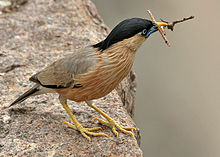 Brahminy Starling, Sturnia pagodarum, with nesting material at Pocharam lake, Andhra Pradesh, India.
Brahminy Starling, Sturnia pagodarum, with nesting material at Pocharam lake, Andhra Pradesh, India.
- Genus Creatophora—Wattled Starling
- Genus Notopholia (sometimes placed in Lamprotornis)
- Black-bellied Glossy-starling, Notopholia corrusca
- Genus Coccycolius—Iris Glossy-starling or Emerald Starling (sometimes placed in Lamprotornis)
- Genus Lamprotornis—typical glossy-starlings (20 species; monophyly requires confirmation)
- Genus Cinnyricinclus—Violet-backed Starling
- Genus Poeoptera (formerly Pholia, sometimes included in Cinnyricinclus)
- Sharpe's Starling, Poeoptera sharpii
- Abbott's Starling, Poeoptera femoralis
- Genus Saroglossa (possibly paraphyletic)
- Spot-winged Starling, Saroglossa spiloptera
- Madagascar Starling, Saroglossa aurata
- Genus Spreo (paraphyletic with Lamprotornis and might be included there)
- African Pied Starling, Spreo bicolor
- Fischer's Starling, Spreo fischeri
- White-crowned Starling, Spreo albicapillus
- Genus Cosmopsarus
- Golden-breasted Starling, Cosmopsarus regius (sometimes placed in Lamprotornis)
- Ashy Starling, Cosmopsarus unicolor (sometimes placed in Spreo)
- Genus Onychognathus
- Red-winged Starling, Onychognathus morio
- Slender-billed Starling, Onychognathus tenuirostris
- Chestnut-winged Starling, Onychognathus fulgidus
- Waller's Starling, Onychognathus walleri
- Somali Starling, Onychognathus blythii
- Socotra Starling, Onychognathus frater
- Tristram's Starling, Onychognathus tristramii
- Pale-winged Starling, Onychognathus nabouroup
- Bristle-crowned Starling, Onychognathus salvadorii
- White-billed Starling, Onychognathus albirostris
- Neumann's Starling, Onychognathus neumanni
- Genus Poeoptera
- Narrow-tailed Starling, Poeoptera lugubris
- Stuhlmann's Starling, Poeoptera stuhlmanni
- Kenrick's Starling, Poeoptera kenricki
- Genus Grafisia—White-collared Starling
- Genus Speculipastor—Magpie Starling
- Genus Neocichla—Babbling Starling
Unresolved
The extinct Mascarene starlings are of uncertain relationships. Only one species is known from specimens taken while the bird was still extant; the other remains only known from subfossil bones and apparently one early traveller's description. The supposed "Leguat's Starling" ("Necropsar leguati") was eventually determined to be a mislabeled albino specimen of the Martinique Trembler ( Cinclocerthia gutturalis), a mimid.
As the avifauna of the Mascarenes is predominantly of Indian origin though as old as to be highly distinct, it is not clear to which clade these starlings belong—or even if they are indeed starlings, as the Réunion Starling at least was highly aberrant and there have always been lingering doubts about whether they are correctly placed here.
- Genus Fregilupus—Réunion Starling (extinct, 1850s)
- Genus Necropsar—Rodrigues Starling (extinct, late 18th century?)

